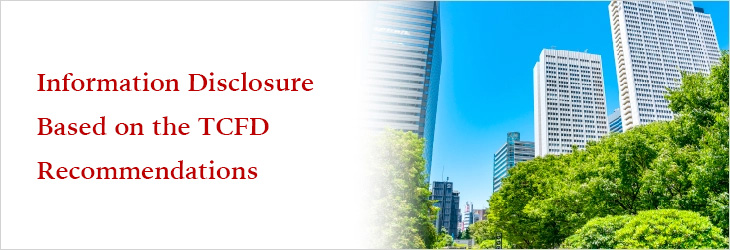
Information Disclosure Based on TCFD Recommendations
Information Disclosure Based on the TCFD Recommendations
Insource Group has incorporated ESG+P management into its medium-term management plan and is promoting sustainable performance improvement while expanding businesses and initiatives that provide social value.
Recognizing climate change as an issue that will have a significant impact on society and our group, we announced our endorsement of the TCFD* recommendations in February, 2021. Recognizing the importance of climate-related financial disclosures, we are committed to disclosing information in line with the framework recommended by the TCFD.
※ Abbreviation for The Task Force on Climate-related Financial Disclosures. It was established in 2015 by the Financial Stability Board (FSB) at the request of the G20. It assesses the financial impact of climate change risks and opportunities on management and recommends disclosure of "Governance," "Strategy," "Risk Management," and "Metrics and Targets".
1.Governance
In July, 2022, Insource Group established a Sustainability Committee, chaired by the Director and Managing Executive Officer. This committee is appointed by the Representative Director, President and Chief Executive Officer and is responsible for promoting management from an ESG perspective with agility, and for managing risks and promoting strategies for overall sustainability, including climate-related issues.
The CO₂ Reduction Subcommittee operates under the Sustainability Committee. The subcommittee is a cross-organizational task force on climate change, which is chaired by the Director and Managing Executive Officer.
The CO₂ Reduction Subcommittee meets monthly, in principle, to report and discuss internal electricity saving projects, CO₂ reduction projects through reducting use of paper, review of greenhouse gas emissions, progress reports on measures such as expanding procurement of renewable energy, check on the progress of performance against environmental targets, and review of climate change topics and initiatives related to our business.
The Director and Managing Executive Officer participates in this task force, and based on reports from each project, including climate-related issues, the Sustainability Committee makes decisions on implementation of measures and reports the activities of the Sustainability Committee to the Board of Directors once a quarter. We also request the attendance of business department managers and outside directors as necessary to ensure the effectiveness and efficiency of our sustainability measures.
Climate-related governance structure

2.Strategy
(1)Climate-related risks and opportunities
In line with the TCFD, climate-related risks are divided into two categories: physical risks (risks related to the physical impacts of climate change) and transition risks (risks related to the transition to a lower-carbon economy). We are considering mitigating both types of risks as they are relevant to our business.
We also believe that the changing needs of our clients for physical and transitional risks due to the advancement of climate change will provide business opportunities for us. As organizations become more concerned about sustainability and demand for compliance with related legislation, the need for human resource development in this area is expected to increase, especially in a 2°Celsius or lower scenario (RCP2.6)

(2)Initiatives related to climate-related risks and opportunities
①Building a flexible system for switching to online training
In the training business, which accounts for approximately 75% of the Insource Group's sales, trainers offer training either at client training sites or in the company's seminar rooms. In the event of extreme weather conditions or severe typhoons that make it difficult for attendees or trainers to travel or assemble, the training may be postponed or cancelled.

Online training (training in an online environment) has been offered since March, 2020. As a result, it is now possible to switch from face-to-face training (conducted in person at a training site) to online training at no additional cost, as long as communication lines are not affected. In addition, we work with clients to set up a schedule that allows them to switch to online training if necessary, and provide suggestions on how to improve their training environment to ensure smooth implementation of training.
②Offering electronic textbooks for training programs
In the training business, we have been providing training services using paper textbooks, but in April, 2022, we launched an electronic textbook service to promote paperless training from the perspective of reducing CO₂ emissions and in response to changing client needs. Introduced for On-Site Training and Open Seminars held online, attendees can now choose between conventional paper textbooks and electronic textbooks in line with their style of training attendance.
This will not only reduce CO₂ emissions and meet client needs, but will also prevent delays in textbook delivery due to social conditions, and is expected to reduce transportation costs. The number of attendees in the training business is 870,000 per year (as of the end of September, 2025), and the target for the first year is approximately 79,000 attendees and a reduction of 11.9-tons of CO₂ emissions from paper use.

The CO₂ Reduction Subcommittee, a subcommittee of the Sustainability Committee, monitors this service and reports to the Board of Directors through the Sustainability Committee and other bodies.
③Developing sustainability-related training
Insource Group has its own content development department and owns more than 3,000 content IPs as of the end of June, 2022. We also develop approximately 300 new training programs per year in response to the external environment and corporate needs, and especially, we have recently stepped up our efforts to develop sustainability-related training in particular. These include themes for learning about sustainability and ESG (SDGs, risk management training, compliance training), corporate reform required for sustainability management, and content to support corporate problem solving (management training, DX training, planning skills training).

As corporate interest in sustainability and demands for compliance with related legislation increase, we anticipate that the need for training these personnel will grow. We will continue our research in the areas of sustainability and climate change, develop new content and quickly make it available on our web pages, and proactively make proposals through emails and visits to clients.
④Company-wide power saving
As a company that provides business improvement services, we are committed to taking the initiative in putting this expertise to use and are actively saving energy throughout the company, using the minimum amount of energy necessary.

Facilities renovations (highly efficient and energy-efficient air-conditioning equipment and LEDs) were implemented at the time of the relocation of the headquarter functions and acquisition of the company building in FY20. In addition, we are raising awareness of power saving within the company. Heat-shielding curtains are attached to window glass surfaces, power strips are turned off at desks when employees leave the office, fans are actively used, and check sheets for air conditioner settings are filled out.
(3)Scenario Analysis
Insource Group has incorporated ESG+P management into its medium-term management plan (Road to Next 2027) and is working to continuously improve Performance while expanding businesses and initiatives that provide social value. In order to confirm the impact of climate change on our overall business, we will conduct scenario analysis, organize climate-related risks and opportunities and analyze the financial impact, and consider our response policy based on priorities.In FY23 and FY24, we focused on the impact of increased flooding, and we are confirming the maximum possible flood depth in all 30 of our Group bases under the 4°C scenario, as well as examining the financial impact and countermeasures.
3.Risk Management
(1)Identifying and assessing climate-related risks and opportunities
Identification and assessment of climate-related risks and opportunities are conducted by the Sustainability Committee and its subordinate organization, the CO₂ Reduction Subcommittee. The identification is updated based on changes in external information, including all short, medium, and long term, and the evaluation is conducted on a case-by-case basis, considering the impact on sales and expenses (major, medium, and minor) and a matrix of likelihood of occurrence (major, medium, and minor). The status of risk and opportunity identification and assessment is reported to the Board of Directors once a quarter.
(2)Managing climate-related risks and opportunities
The Sustainability Committee and the Risk Compliance Committee monitor the Group's overall management of climate change-related risks and opportunities on a quarterly basis, and consider and decide on measures to address climate-related risks, taking into account the external environment, the status of initiatives, and information from the service delivery departments. The committee also reviews and decides on measures to address climate-related risks.
The Risk Compliance Committee, chaired by the President and CEO, defines risk as events that may cause losses in our business activities, and manages climate-related risks in an integrated manner with other risks.
4.Metrics and Targets
Although our CO₂ emissions are not as high as those of other industries due to our dependence on natural capital and lack of large-scale production equipment, we are increasing our workforce and expanding our locations with a goal of 20% growth each year. Therefore, our energy use is increasing every year. In order to respond to climate change risks and opportunities and to promote activities to reduce environmental impact from a long-term perspective, we have set the following goals and are promoting our business activities.
(1)Actual environmental impact of the Group's business activities
Please visit our Sustainability Data page.
(2)Targets and indicators for reducing the environmental impact of the Group's business activities
- ・Achieve "net zero" CO₂ emissions (Scope 1+2) from business activities by 2050
- ・Reduce Scope 2 (CO₂ emissions from electricity) by 50% from the 2020 level by 2030
- ・Reduce CO₂ emissions from in-house paper use by 50% from 2020 levels by 2030
-
Sustainability
-
E(Environment)
-
S(Social)
-
Contributing to Society through Business
-
Human Capital
-
Regional Co-creation Activities
-
-
G(Governance)


